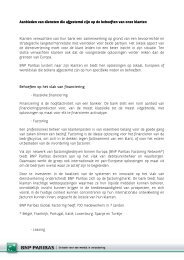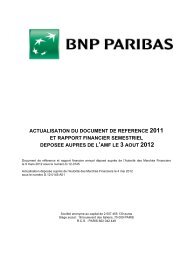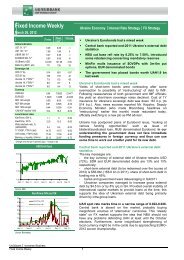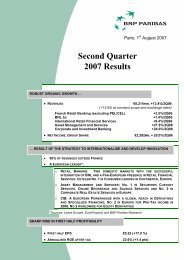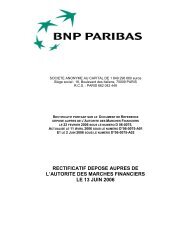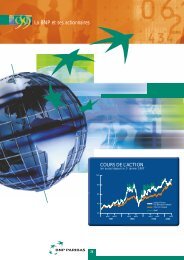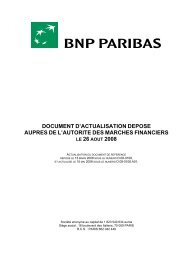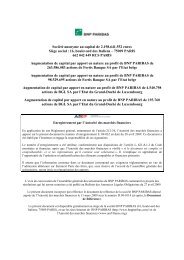RepoRt on - BNP Paribas
RepoRt on - BNP Paribas
RepoRt on - BNP Paribas
Create successful ePaper yourself
Turn your PDF publications into a flip-book with our unique Google optimized e-Paper software.
NRE indicator - 2009 year Scope for 2009<br />
5. Use of renewable energy sources<br />
Outside France, subsidiaries have pi<strong>on</strong>eered local initiatives to purchase green electricity.<br />
This is the case of Bank of the West in the United States, <strong>BNP</strong> <strong>Paribas</strong> Fortis in Belgium<br />
and BGL <strong>BNP</strong> <strong>Paribas</strong> in Luxembourg.<br />
In Italy, BNL opened a new bank branch which is energy self-sufficient using solar power.<br />
The branch, which is located in the city of Alessandria, is fitted with photovoltaic panels that generate<br />
clean energy. This ensures that the branch generates sufficient energy to cover its entire energy<br />
c<strong>on</strong>sumpti<strong>on</strong>. The first energy self-sufficient bank branch using photovoltaic solar power<br />
was inaugurated in Rome in 2008.<br />
data gathered <strong>on</strong> electricity purchasing in Europe is used to analyse energy purchasing strategies<br />
and evaluate opportunities for greater use of renewable energies. Owing to the wide variati<strong>on</strong><br />
in power sources marketed as “green energy” as well as the price premium associated<br />
with such sources, the Group has not set a global target for green power c<strong>on</strong>sumpti<strong>on</strong> at this time.<br />
For the moment, the key priority is to reduce c<strong>on</strong>sumpti<strong>on</strong> of electricity which has an immediate<br />
impact <strong>on</strong> the envir<strong>on</strong>ment. Group<br />
6. Land use<br />
For real estate development projects, <strong>BNP</strong> <strong>Paribas</strong> Real Estate hires a specialised c<strong>on</strong>sulting firm<br />
to c<strong>on</strong>duct a diagnostic review of the extent of soil c<strong>on</strong>taminati<strong>on</strong>. A soil identificati<strong>on</strong> programme is<br />
developed, c<strong>on</strong>taminati<strong>on</strong> studies are performed using tests and analyses, and a soil report is drawn up.<br />
<strong>BNP</strong> <strong>Paribas</strong> Real Estate uses the findings of the c<strong>on</strong>taminati<strong>on</strong> evaluati<strong>on</strong> to perform<br />
any remediati<strong>on</strong> work necessary to ensure that soil meets applicable regulatory requirements.<br />
In additi<strong>on</strong> to these initiatives, the Group applies envir<strong>on</strong>mental housing certificati<strong>on</strong> provisi<strong>on</strong>s<br />
to a large number of <strong>BNP</strong> <strong>Paribas</strong> Real Estate’s development projects. These entail c<strong>on</strong>taining polluti<strong>on</strong><br />
nuisances with a view to meeting the objectives required in terms of health, ecological balance<br />
and comfort of use. France<br />
7. Emissi<strong>on</strong>s into air, water and soil<br />
discharges into water and soil are not taken into account as they are n<strong>on</strong>-material.<br />
Robust indicators are used within the Group to calculate CO 2 emissi<strong>on</strong>s.<br />
data is collected for a scope equivalent to 64% of the Group’s worldwide NPP headcount<br />
and relates to electricity c<strong>on</strong>sumpti<strong>on</strong> and work-related travel by car, train and air. Based <strong>on</strong> this data,<br />
emissi<strong>on</strong>s of CO 2 equivalent are estimated at 2.34 t<strong>on</strong>nes per NPP employee.<br />
Actual c<strong>on</strong>sumpti<strong>on</strong> levels vary substantially from country to country, reflecting c<strong>on</strong>diti<strong>on</strong>s in each<br />
geographical area as well as variati<strong>on</strong>s in the energy use mix and in the nature of the Group’s<br />
operati<strong>on</strong>s. As an example, the Group estimates emissi<strong>on</strong>s of CO 2 equivalent per NPP employee<br />
as follows:<br />
• United States: 5.40 t<strong>on</strong>nes of CO 2 equiv. per NPP;<br />
• France: 1.47 t<strong>on</strong>nes of CO 2 equiv. per NPP;<br />
• Italy: 4.16 t<strong>on</strong>nes of CO 2 equiv. per NPP;<br />
• Luxembourg: 2.22 t<strong>on</strong>nes of CO 2 equiv. per NPP;<br />
• United Kingdom: 7.02 t<strong>on</strong>nes of CO 2 equiv. per NPP;<br />
• Switzerland: 1.47 t<strong>on</strong>nes of CO 2 equiv. per NPP.<br />
Calculati<strong>on</strong> methods take into account emissi<strong>on</strong>s generated by the producti<strong>on</strong>, transmissi<strong>on</strong><br />
and c<strong>on</strong>sumpti<strong>on</strong> of energy. For electricity, the primary energy source used by the producer is taken<br />
into c<strong>on</strong>siderati<strong>on</strong>. For air travel, criteria used include fuel c<strong>on</strong>sumpti<strong>on</strong>, average load factors,<br />
the distincti<strong>on</strong> between short and l<strong>on</strong>g-haul flights, and the class in the passenger cabin occupied<br />
by travellers. For car travel, the methodology assesses emissi<strong>on</strong>s based <strong>on</strong> kilometres travelled,<br />
rated horsepower of the vehicle and type of fuel.<br />
Excepti<strong>on</strong>ally, the 2009 assessment of CO 2 emissi<strong>on</strong>s worldwide was performed using the Bilan<br />
Carb<strong>on</strong>eTM (V6.0) method in collaborati<strong>on</strong> with a c<strong>on</strong>sultancy licensed by the French Envir<strong>on</strong>ment<br />
and Energy Management Agency (AdEME) for the scope prior to the Fortis merger, and using<br />
the Greenhouse Gas Protocol method for the scope of the former Fortis Bank.<br />
141 <str<strong>on</strong>g>RepoRt</str<strong>on</strong>g> <strong>on</strong> CoRpoRate SoCial and enviR<strong>on</strong>mental ReSp<strong>on</strong>Sibility<br />
Group - 64%<br />
of worldwide NPP<br />
headcount<br />
In France, emissi<strong>on</strong>s from commuting are estimated using three c<strong>on</strong>centric circles, <strong>on</strong>e for employees<br />
living in the city, a sec<strong>on</strong>d for those living in the inner suburbs or just outside a regi<strong>on</strong>al city,<br />
and a third for those living in the outer suburbs or a rural area. Emissi<strong>on</strong>s generated by these trips are<br />
then estimated based <strong>on</strong> the form of transport used. The detailed study carried out in 2009 in the Paris<br />
regi<strong>on</strong> in c<strong>on</strong>juncti<strong>on</strong> with the enterprise transport plan provided an opportunity to refine and improve<br />
the estimate by examining the commuting patterns of a sample populati<strong>on</strong> of 22,000 people.<br />
The estimate of CO 2 equivalent emissi<strong>on</strong>s generated in France including emissi<strong>on</strong>s from commuting<br />
is estimated at 2.39 t<strong>on</strong>nes of CO 2 equivalent per NPP versus 2.59 t<strong>on</strong>nes of CO 2 equivalent in 2008. France<br />
The statistical margin of error of these estimates which reflects the uncertainties linked to data<br />
c<strong>on</strong>versi<strong>on</strong> and the reliability of data gathering in each country is 20%.




